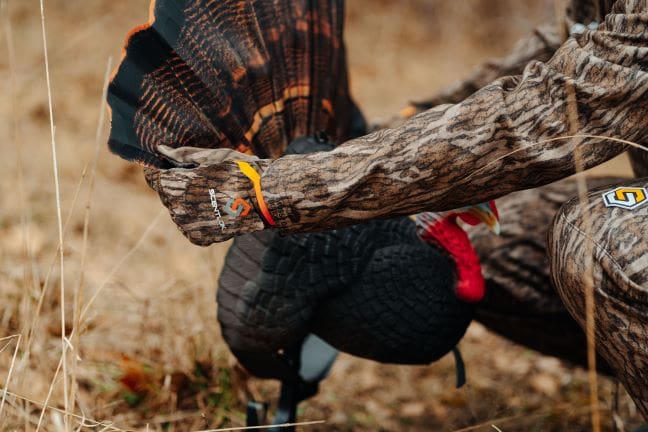Bowhunting for turkeys during the spring is a thrilling pursuit that promises excitement and challenge. With their keen eyesight and quick movements, turkeys present a challenging target for bowhunters. However, a successful hunt is within reach with careful preparation and knowledge.
Twenty-three years ago, after graduating high school, I was in a dilemma, unsure which career path to pursue. With the weight of responsibility for my future settling in, I did what any country boy would do—I escaped into the woods, bow in hand, and spent every day of October immersed in bowhunting. For several weeks, I found solace in the crisp autumn mornings, perched twenty feet high in a tree, bow in hand. While the endeavor didn’t line my pockets, it imparted a crucial lesson in bowhunting. Like clockwork, a flock of turkeys would amble each morning along the timber ridge, just beyond my bow’s reach. Despite numerous encounters in less-than-ideal scenarios, I was determined to outsmart them and notch a successful shot with my bow.
Over time, I gathered insights into what tactics worked, what spooked them, the art of concealment, and the necessity of deploying every trick in the book to secure the shot. It wasn’t until a couple of seasons later that I finally achieved my goal of harvesting my first turkey with a bow. Admittedly, the journey wasn’t easy, and even now, I can’t claim it’s gotten any easier. Whether in the autumn, similar to my first hunt, or during the ever-popular spring season, there are five indispensable tips every aspiring bowhunter should heed before embarking on their turkey-hunting quest.
Shot Placement
Understanding where to aim for a turkey is crucial for a quick and ethical harvest. Unlike the giant games, turkeys have smaller vital areas. Although turkeys have several vital target areas on their tiny bodies, aim for the base of the neck or the head for the most effective shot placement. Some hunters will say the head is too small of a target, making them aim for the body instead. However, I have tried aiming slightly behind the wings where it joins the body, in the heart and lung area, but with all the thick feathers, the actual kill zone is not much bigger than the head. Plus, I have always shot turkeys in the head with a shotgun; I’ll stay with what works best. Like any other wild game pursued with a bow, practicing on a life-like turkey target can help refine the accuracy and improve the chances of a clean kill. That is why ensuring you practice shooting your bow before heading out for a hunt is so important.
Concealment
Turkeys possess exceptional eyesight, making concealment a top priority for bow hunters. Some twenty-plus years ago, I learned that concealment is the most critical factor when getting turkeys into shooting range, drawing the bow, and making the shot.
Choose camouflage clothing that matches your surroundings and utilize natural cover to break up your silhouette. Many bowhunters use a ground blind or a quick pop-up style blind to help hide themselves, yet if camouflaged well, the shot can be achieved from the ground, using the available natural cover. Remember, when drawing your bow, wait for the turkey to look away or position yourself behind the cover to avoid detection; the rest becomes natural.
Decoys
Using decoys can be a game-changer in enticing turkeys into close range. In my experience, the primary goal of any decoy is to draw the animal’s attention to a designated spot while diverting their focus away from the hunter. This principle holds true when employing turkey decoys for bowhunting. Position decoys strategically to attract approaching birds and keep their attention away from your position, and you will be able to draw your bow without being seen. Consider using realistic decoys with lifelike movements, such as a moving tail fan; realistic looks and movements help enhance their effectiveness.
Proper Setup
The right equipment is essential for a successful turkey hunt with a bow. Opt for a shorter axle-to-axle bow that offers maneuverability in tight spaces. Additionally, choose a bow with a smooth drawing cycle and consider reducing poundage to facilitate easier drawing when it is time to make the harvest. Also, if you aim for the head, as I prefer, utilize broadheads designed explicitly for turkeys to maximize lethality and ensure clean kills. Many broadheads on the market expand and feature tips designed to impact a turkey’s head.
Keep A Rangefinder Close By
Knowing your comfortable shooting range is imperative for a successful hunt. Practice regularly to familiarize yourself with your bow’s capabilities and accuracy at various distances. Additionally, always carry a rangefinder to gauge the distance to your target accurately before taking the shot. Being prepared and confident in your shooting range can significantly increase your chances of success in the field.
As you venture into the woods this spring season, embarking on the exhilarating pursuit of turkey hunting with a bow, remember that success lies in meticulous planning, unwavering patience, and honed skills. By mastering shot placement, prioritizing concealment, skillfully deploying decoys, optimizing your setup, and knowing your shooting range, you can tilt the odds of success in your favor.


